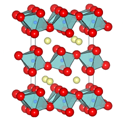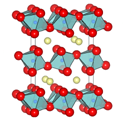Squeezing in magnetism
Strong Coulomb interactions and anisotropic crystal structure play an important role in the many forms of order that are seen in the transition-metal oxides. Small changes in the composition or structure of a material can lead to dramatic changes in its properties. A particular example is . In its natural form, this material crystallizes into a perovskite structure and does not show any form of long-range magnetic order. However, adding a tiny amount of disorder makes ferromagnetic, implying that this phase lies close to a magnetic critical point.
In a paper appearing in Physical Review B, Yuichi Shirako of Gakushuin University and colleagues at several institutions in Japan have synthesized with a different crystal structure from the natural one, without changing its chemical composition. Shirako et al. prepared in the so-called postperovskite structure by applying high pressure and high temperature and then quenching the material to retain that structure at room temperature. This new crystal is only denser than the perovskite structure but has a significantly more anisotropic crystal structure. This form of appears to be a quasi-one-dimensional magnet, implying long-range antiferromagnetic correlations between the spins on the ruthenium ( ) sites. If so, it would be the first example of a antiferromagnetic integer spin chain involving the orbitals of the metal ions in a correlated oxide. This dramatic effect from a small change is likely to spur interest in further studies of isocompositional versions of other oxides and the effects of carrier doping on them. – Sarma Kancharla





